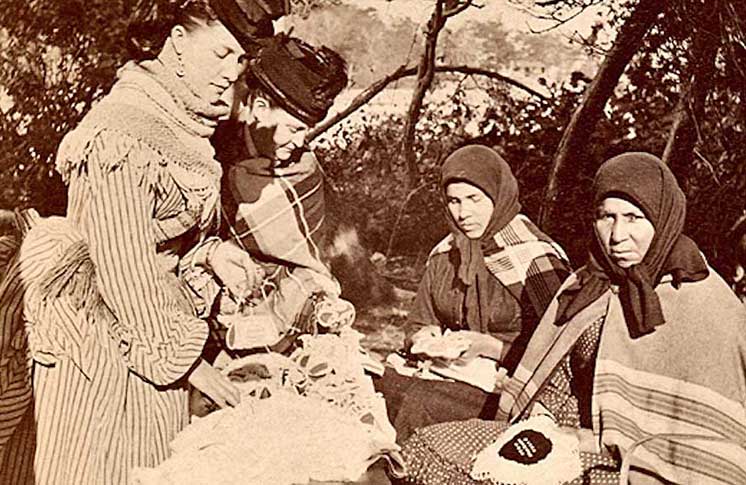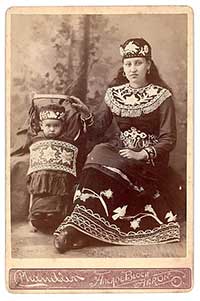
Picking out a handmade Iroquoian beaded souvenir at Niagara Falls was all the rage for Victorian ladies in the late 1800’s to early 1900’s.| Image Source: iroquoisbeadwork.blogspot.ca
In the crowded pow wow arena – the beadwork of the Haudenosaunee people is unmistakable and instantly recognizable. Delicate white beads on dark rich velvet, stitched in raised lines depicting flowers, clan animals and traditional patterns make Iroquoian beadwork stand out as a stunning art form.
Since the beginning of our confederacy the Haudenosaunee people have used beads to document political values and tell stories of the changing world around us. Traditional beads made from shell, quartz and even copper were used to mark status, share information and even to bring good luck.
But it was in the early 17th century when the Haudenosaunee world and the Western world began to interact that the tastes of Iroquoian mothers, aunties and grandmothers turned to what we know today as raised Iroquoian style beadwork.
The tale goes that the indigenous women loved the delicate look of the English lace that women were wearing. While they could not acquire things like lace or the materials to create it – they had liberal access to white glass beads via the trade network and learned to use these delicate beads on dark backgrounds to replicate the look of lace.
The McCord Museum of Canadian History in Montreal has an online exhibit; “Across Borders: Beadwork in Iroquois Life” showing over 80 artifacts, some dating back to the 1600’s, that tell the story of Iroquoian beadwork.

“The Iroquois, through their crucial role in the early fur trade, gained access to iron axes, copper kettles, cloth, glass beads and steel needles,” according to the Across Borders Exhibition text. “Glass beads, brilliant and translucent, were quickly integrated into Iroquois belief systems and became a staple in gift exchanges linked to alliances and treaties.”
It was during this collision of the indigenous world and the western world that Iroquoian people began to construct distinctly vibrant clothing to set them apart from settlers – affirming Haudenosaunee identity and sovereignty.
“Traditionally, women family members and friends gathered in each other’s homes to make beadwork. Iroquois artists working today explain that, as children, they learned much more than how to sew as they watched and listened to elder beadworkers. Even if too young to join the sewing circle, children were assigned other tasks, such as sorting beads, picking stray beads off the floor and preparing snacks and tea. Beadworkers recall their grandmothers talking about how families lived long ago,” the text continues.
Creating lovely things was not just a mark of distinct Haudenosaunee culture however. By the late 1800’s/early 1900’s the Seneca’s had made a name for themselves in upstate New York. Rich tourists began taking note of the intricately beaded bags on their summer vacation travels to Niagara Falls. With clever marketing and the power of the Victorian romanticism of the ‘Savage Indian’ – Iroquoian Beadwork suddenly became an accessible solution to bringing home some money for several families. Eventually, Iroquoian souvenirs became synonymous with a Niagara Falls vacation.
The industry grew, and beaded souvenirs were being marketed everywhere in Haudenosaunee country from Montreal to Niagara Falls; some going door to door, some at markets, train stations and tourist resorts.
In fact, Iroquoian beadwork was such a huge part of the indigenous economy in the Great Lakes area that the Tuscarora were actually given an exclusive right to sell beadwork at major tourist locations in “recognition of their loyalty during the American Revolution”.
However times changed, markets shifted and the cry for beaded souvenirs eventually declined to a whisper. But the internal demand within Haudenosaunee culture for an authentically beaded decoration is still quite lucrative – with an expertly beaded pair of moccasins selling anywhere from $400 to $1500 a pair.
It is a beautiful art form that still exists today, and a beautiful story of the symbols of Haudenosaunee history and life.
Source: “Across Borders: Beadwork in Iroquois Life” Exhibition Text, 1999-2000. McCord Museum of Canadian History.

This piece originally appeared on Two Row Times and is reprinted with permission.

Nahnda Garlow Bio
Nahnda Garlow, Onondaga under the wing of the Beaver Clan of Six Nations, is our Arts & Culture editor. Her popular column, Scone Dogs and Seed Beads brings weekly thoughts on current day indigenous identity. She is a self-proclaimed “rez girl” who brings to the Two Row Times years of experience as a cultural interpreter, traditional dancer and beadwork aficionado.









